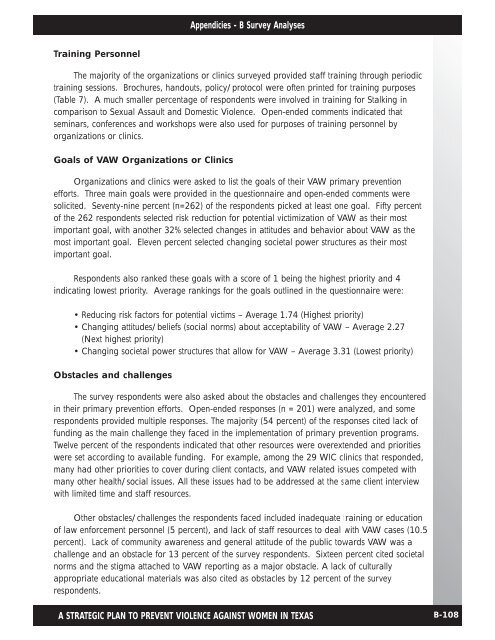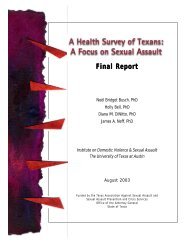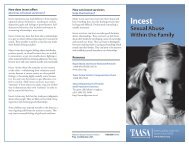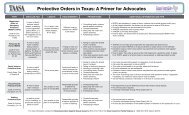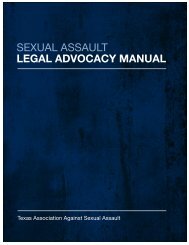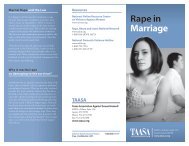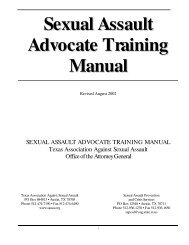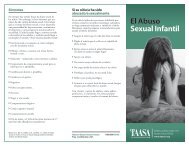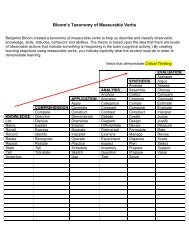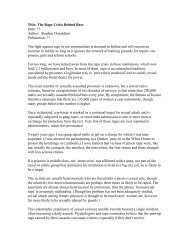TDH Booklet4 - Texas Association Against Sexual Assault
TDH Booklet4 - Texas Association Against Sexual Assault
TDH Booklet4 - Texas Association Against Sexual Assault
Create successful ePaper yourself
Turn your PDF publications into a flip-book with our unique Google optimized e-Paper software.
Appendicies - B Survey Analyses<br />
Training Personnel<br />
The majority of the organizations or clinics surveyed provided staff training through periodic<br />
training sessions. Brochures, handouts, policy/protocol were often printed for training purposes<br />
(Table 7). A much smaller percentage of respondents were involved in training for Stalking in<br />
comparison to <strong>Sexual</strong> <strong>Assault</strong> and Domestic Violence. Open-ended comments indicated that<br />
seminars, conferences and workshops were also used for purposes of training personnel by<br />
organizations or clinics.<br />
Goals of VAW Organizations or Clinics<br />
Organizations and clinics were asked to list the goals of their VAW primary prevention<br />
efforts. Three main goals were provided in the questionnaire and open-ended comments were<br />
solicited. Seventy-nine percent (n=262) of the respondents picked at least one goal. Fifty percent<br />
of the 262 respondents selected risk reduction for potential victimization of VAW as their most<br />
important goal, with another 32% selected changes in attitudes and behavior about VAW as the<br />
most important goal. Eleven percent selected changing societal power structures as their most<br />
important goal.<br />
Respondents also ranked these goals with a score of 1 being the highest priority and 4<br />
indicating lowest priority. Average rankings for the goals outlined in the questionnaire were:<br />
• Reducing risk factors for potential victims – Average 1.74 (Highest priority)<br />
• Changing attitudes/beliefs (social norms) about acceptability of VAW – Average 2.27<br />
(Next highest priority)<br />
• Changing societal power structures that allow for VAW – Average 3.31 (Lowest priority)<br />
Obstacles and challenges<br />
The survey respondents were also asked about the obstacles and challenges they encountered<br />
in their primary prevention efforts. Open-ended responses (n = 201) were analyzed, and some<br />
respondents provided multiple responses. The majority (54 percent) of the responses cited lack of<br />
funding as the main challenge they faced in the implementation of primary prevention programs.<br />
Twelve percent of the respondents indicated that other resources were overextended and priorities<br />
were set according to available funding. For example, among the 29 WIC clinics that responded,<br />
many had other priorities to cover during client contacts, and VAW related issues competed with<br />
many other health/social issues. All these issues had to be addressed at the same client interview<br />
with limited time and staff resources.<br />
Other obstacles/challenges the respondents faced included inadequate training or education<br />
of law enforcement personnel (5 percent), and lack of staff resources to deal with VAW cases (10.5<br />
percent). Lack of community awareness and general attitude of the public towards VAW was a<br />
challenge and an obstacle for 13 percent of the survey respondents. Sixteen percent cited societal<br />
norms and the stigma attached to VAW reporting as a major obstacle. A lack of culturally<br />
appropriate educational materials was also cited as obstacles by 12 percent of the survey<br />
respondents.<br />
A STRATEGIC PLAN TO PREVENT VIOLENCE AGAINST WOMEN IN TEXAS<br />
B-108


